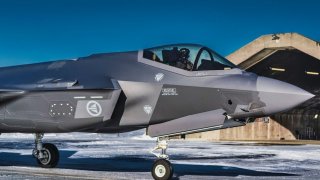S-400: The Russian Air Defense System NATO Hates Keeps Causing Problems
The S-400 is the premier air defense system developed and deployed by Russia. Turkey purchased it and was thrown out of the F-35 program.
Turkey's S-400 'Triumf' Air Defense Systems Not Active - It could be argued that if the Turkish government knew in advance that its purchase of the Russian-made S-400 'Triumf' air defense system would have caused such a rift with its NATO allies, it might not have opted to acquire the platform in the first place. However, Ankara reached a point of no return, refusing to budge over its plan to adopt the Russian hardware – even as it resulted in its expulsion from the F-35 program.
Turkey had been a part of the supply chain for the Lockheed Martin F-35 Lightning II, and reportedly paid $1.25 billion to participate in the effort. Producing parts for the fifth-generation aircraft was expected to have generated $9 billion in revenue for Ankara, while six F-35 aircraft produced for Turkey were not delivered.
Not Currently Active
What is notable is that despite Turkey's determination to move forward to adopt the Triumf, the system hasn't been made operational
On Saturday, Turkish Defense Minister Yaşar Güler told reporters that the S-400 system would only be utilized when needed.
"This is a defense system. Don't we use a defensive weapon when someone attacks us? No country launches an attack on another by declaring, 'I will attack you in two hours.' In a wartime scenario, you need to move your aircraft, operate hundreds of trains and declare mobilization, and so on. In other words, for a country to launch an airstrike on another without anyone noticing is very difficult," Güler told journalists, per NordicMonitor.com.
Moscow had sent two S-400 batteries as well as more than 120 long-range missiles as part of the agreement along with experts to train Turkish soldiers on how to operate the Triumf. A second batch has yet to be delivered.
Not Compatible Systems
Washington has maintained that the F-35 stealth fighter jet is incompatible with the S-400, and there have been fears that Russia could use Turkey's Triumf systems to determine weaknesses in the F-35 jet. The sentiments were reiterated by NATO Secretary-General Jens Stoltenberg who also noted that the S-400 cannot be integrated with NATO air and missile defense systems.
The U.S. State Department also called the acquisition of the Russian platform unacceptable.
For its part, Ankara claimed it was forced to purchase the S-400 Triumf as Washington refused to sell Turkey the U.S. Patriot missile system.
Is Turkey Heeding Warning From Washington?
Turkey first signed the S-400 deal with Russia in 2017, and the deliveries of the first four missile batteries, worth a reported $2.5 billion, began on July 12, 2019.
Yet, Ankara has seemed to heed Washington's warning that activating the S-400 missiles or buying a second batch would trigger heavier sanctions under the Countering America's Adversaries through Sanctions Act (CAATSA). On December 14, 2020, the US imposed sanctions on Turkey's Presidency of the Defense Industry (Savunma Sanayii Başkanlığı, SSB) and certain of its principal officers over the S-400 procurement.
As the NordicMonitor also reported, the Turkish government has been concealing from the public that the S-400 system has not been activated and is also working to prevent the perception that the money spent on the air defense system was essentially wasted. Moreover, the promised technology transfer associated with the purchase of the S-400s has not materialized.
Russia's Air Defense System in the Crosshairs
The S-400 Triumf system (NATO reporting name: SA-21 Growler), which was developed and produced by Almaz-Antey, was designed to protect from airstrikes, including cruise, tactical, and operational ballistic missiles as well as intermediate-range missiles in a radio-jamming environment.
It can also be used against ground installations. The S-400, which can also launch 40N6 missiles, is designed to engage targets at a distance of up to four hundred kilometers at up to six times the speed of sound and at an altitude of up to thirty kilometers under intensive enemy fire and jamming. It first entered service in 2007.

The S-400's mission set and capabilities are considered to be comparable to the U.S. Patriot system. Yet, unlike some Patriot interceptors, the S-400 does not currently employ hit-to-kill ballistic missile defense technology.
At the start of 2023, Russia had 96 S-400s in service. At least five of the systems have come under attack – including strikes on the command posts, launcher, or radars.
Russia also supplied the S-400 to India, which purchased the air defense system units in 2018 for $5.4 billion. Three of the systems have been delivered, while two more are still awaited.
Author Experience and Expertise
Peter Suciu is a Michigan-based writer. He has contributed to more than four dozen magazines, newspapers, and websites with over 3,200 published pieces over a twenty-year career in journalism. He regularly writes about military hardware, firearms history, cybersecurity, politics, and international affairs. Peter is also a Contributing Writer for Forbes and Clearance Jobs. You can follow him on Twitter: @PeterSuciu.
All images are Creative Commons.


